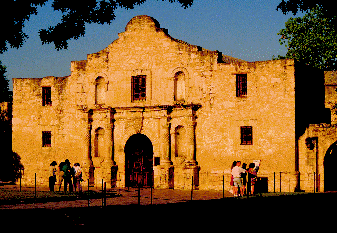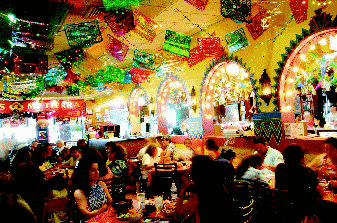San Antonio to Host Display Week 2009
Display Week gets done Texas-style this year in San Antonio, Texas, with one of the oldest cities in the American West hosting some of the latest display technology in the world. Here's what to see and do when you're not attending Display Week 2009.
by Jenny Donelan
"REMEMBER THE ALAMO!" and "Don't forget the River Walk!" are standard marching orders for most visitors to San Antonio. And while these attractions are consistently and deservedly ranked among the top 10 in all of Texas, there are many other things to see and do in this sunny city with Spanish roots. Visitors to Display Week 2009 (The SID International Symposium, Seminar & Exhibition) can also enjoy historic sites, open-air markets and dining, world-class museums, and, of course, the region's legendary Tejano culture.
Whatever you do in San Antonio, do some of it outdoors. Temperatures average between 72 and 92°F in June. Bright days are the norm, with the city enjoying an average of 300 days of sunshine. So, take a walk.
The Big Two
The Alamo and the River Walk are an easy stroll from the Henry B. Gonzalez Convention Center, where Display Week will take place. They are not to be missed. If you only have time to see two things besides the show floor and the inside of your hotel room while at the conference, by all means get yourself to the River Walk and the Alamo.
So why are we supposed to remember the Alamo, anyway? It's where, during the Texas Revolution in 1836, 189 Texas defenders held off Mexican General Santa Anna's 4000 soldiers for 13 days. After those 13 hard-fought days, things went distinctly worse for the defenders, so we honor their lost lives through memory. The 300-year-old Alamo, originally a mission, is often referred to as "the shrine of Texas liberty," and looms large in the patriotic mental landscapes of U.S. citizens and of Texans especially.
First-time visitors to the Alamo may be in for a surprise if they have imagined it as (a) large or (b) in a barren landscape as it appears in films such as the 1960 John Wayne movie by the same name. The Alamo is actually not one building, but a 4.2-acre complex including three modest buildings and a garden. And it is directly in the middle of the city. Still, the sense of history in this place is palpable. For example, as a sign of respect, gentlemen are still instructed to remove their hats when entering the complex. You can take a look at the grounds most any time of day and visit the indoor exhibits during open hours. The Alamo is operated by the Daughters of the Republic of Texas.

The landmark known as the Alamo was originally the Mission San Antonio de Valero, founded by the Spanish in 1718. Photo Courtesy of the San Antonio Convention & Visitors Bureau/Al Rendon.
The River Walk (also known as the Paseo del Río) is just a short distance from the Alamo. It consists of a network of pedestrian walkways, lined with restaurants and shops, that runs along the San Antonio River below street level. Perhaps that depth is what gives the River Walk a sense of being its own world, a city within a city. In any case, it's a great place to relax. Set yourself up with a prickly pear margarita at a café along the water, order guacamole to be made at your table, and watch the parade of colorful, tourist-filled boats pass by. You can take a river taxi or tour yourself, or even dine on a boat. Many of the local restaurants offer on-river dining.
A Sense of History
San Antonio was the site of a native American settlement when a Franciscan Father stopped by and bestowed its current name on it sometime in the late 17th century. In 1718, Spain established the Mission San Antonio de Valero (later to be called the Alamo) on the site. Consequently, San Antonio is an old city by Western standards, and one with a unique mixture of native American, Mexican, Spanish, German, and other European settlers.
The San Antonio Missions National Historic Park contains a grist mill and four historic missions: Concepción, San José, San Juan, and Espada. Each mission is still an active Catholic parish that holds regular services. If you have time, you can travel from mission to mission on the 8-mile Missions Bike and Hike Trail.

River boat tours and riverside dining are both popular with visitors to San Antonio. Photo courtesy of the San Antonio Convention & Visitors Bureau/Al Rendon.
Built by German merchants in the late 1800s, the King William Historic District is the oldest historic district in Texas. You can take a self-guided walking tour (available from the San Antonio Conservation Society as listed later in this article) to view the neighborhood's large, impressive houses. There are also restaurants, bed-and-breakfasts, and art galleries.
La Villita Historical Art Village, "the little village," is located on the south bank of the San Antonio River. La Villita was San Antonio's first neighborhood, established by Spanish soldiers stationed at the Alamo. Now it's home to art galleries, craft and jewelry shops, clothing stores, and numerous restaurants.
A View and a Zoo
History of a different sort is evident at the Tower of the Americas, an observation tower that looks exactly like the 1968 World's Fair centerpiece it once was. The observation deck and revolving restaurant have recently undergone renovations, however. You can ride a glass elevator up the structure to literally upscale dining, enjoying unbeatable views all the way. The Tower also features a 4-D ride called "Skies Over Texas."
The San Antonio Zoo and Aquarium is the third largest in Texas and one of the oldest zoos in the country as well. More than 3500 animals representing 600 species are on hand here. At press time, the aquarium was being renovated and was scheduled to reopen in the spring.
High and Low Culture
San Antonio has many more museums than can be listed here. One of the most famous is the McNay Art Museum, known for its collection of 19th- and 20th-century European and American art displayed in a Mediterranean villa and courtyard. The McNay Art Museum was the first museum of modern art in Texas. Among the painters and sculptors represented here are Paul Cézanne, Vincent van Gogh, Auguste Rodin, Henri Matisse, Pablo Picasso, Edward Hopper, and Georgia O'Keeffe.
You'll also want to be sure to check out the San Antonio Museum of Art, housed in a turn-of-the-century building that was once the Lone Star Brewery. This museum has the most comprehensive collection of Latin American art in the United States, as well as an assembly of Egyptian, Roman, and Greek antiquities.
Because you really are in the southwest after all, a must-see is the Buckhorn Saloon & Museum, which includes separate museums dedicated to horns, fins, and feathers (yup), as well as the Hall of Texas History Wax Museum (which also, not incidentally, had its start at the 1968 World's Fair). There is a curio store dating back to 1920 and last, but not least, an actual saloon in which you can enjoy a cold frosty rootbeer or other beverages of your choice at the venerable establishment's 120-year-old bar.
|
Getting to and around San Antonio
San Antonio International Airport (SAT) is located about 8 miles from the center of town. A taxi ride from the airport to the city center takes about 20 minutes and costs approximately $25. SATRANS, the San Antonio Airport Shuttle, also offers transportation to all the downtown hotels for about $18. You can book a shuttle in advance online or buy a ticket in the baggage claim area once you arrive.
For more information contact:
• Airport: http://www.sanantonio.gov/aviation
• SATRANS: http://www.saairportshuttle.com
A great place to start your visit is the San Antonio Visitor Center (http://www.visitsanantonio.com/visitors/plan/visitor-information-center/index.aspx), located across from the Alamo. Many of the major sites in San Antonio are within walking distance of the convention center, but the city also offers several public-transportation options designed especially for visitors:
• Streetcar: These are open-air reproductions of the type of rail streetcar that serviced San Antonio more than half a century ago. Four streetcar routes stop at sights such as the Alamo and La Villita, and in downtown shopping areas. There is a streetcar station near the convention center. A one-day pass is $4.
• River Taxi: River cruisers with black and yellow checkered flags stop at 39 locations along the River Walk. A one-way pass is $4; a 24-hour pass is $10.
• Sightseer Special Bus: Bus 7 runs daily between the city's popular sites, including the River Walk Streetcar Station, Henry B. Gonzalez Convention Center, the Alamo, the San Antonio Museum of Art, and the San Antonio Zoo.
For more information on bus and streetcar service in San Antonio contact:
• Via Metropolitan Transit: http://www.viainfo.net
For river tours, river taxis, and on-board dining contact:
• Rio San Antonio Cruises: http://www.riosanantonio.com
Web Sites for San Antonio
General Information
• The Official Site of Texas Tourism: www.traveltex.com
• San Antonio Convention & Visitors Bureau: http://www.visitsanantonio.com/visitors/plan/visitor-information-center
Historic Attractions
• The Alamo: www.thealamo.org
• King William Historic District: http://www.saconservation.org/tours/sitevisits_kingwilliam.htm
• La Villita Historic Arts Village: http://www.lavillita.com
• San Antonio Missions National Historic Park: http://www.nps.gov/saan
Destinations
• The River Walk: http://www.thesanantonioriverwalk.com
• San Antonio Zoo and Aquarium: http://www.sazoo-aq.org
• Tower of the Americas: http://www.toweroftheamericas.com
Museums
• Buckhorn Saloon & Museum: http://www.buckhornmuseum.com
• McNay Art Museum: http://www.mcnayart.org
• San Antonio Museum of Art: http://www.samuseum.org/main
Theme Parks
• Schlitterbahn Waterpark Resort: http://www.schlitterbahn.com/nb
• SeaWorld San Antonio: http://www.seaworld.com/sanantonio
• Six Flags Fiesta Texas: http://www.sixflags.com/fiestaTexas
|
Theme Parks Wet, Wetter, and Wettest
Six Flags Fiesta Texas boasts eight roller coasters, including the famed Superman Krypton Coaster, the largest steel coaster in the southwest, and Big Bender, with its tunnels, waterfalls, and five-story drop. There's also a 90-ft. Ferris wheel, a boardwalk, shows, and much more.
SeaWorld San Antonio is the largest marine-life adventure park in the world. You can ogle the sea life at a show at Shamu Stadium, then visit any of SeaWorld's four individual parks, including some with water rides.
Water park connoisseurs speak in reverent tones of Schlitterbahn Waterpark Resort in New Braunfels, Texas, about 40 minutes north of San Antonio. The state-of-the-art resort has 65 acres of water-based amusements, including an uphill water coaster six stories tall, miles of tube chutes, kid-friendly water playgrounds, and river rafting.
Even though San Antonio is the second-largest city in Texas, it's not so large that you can't see at least some of it when you're not taking in seminars, presentations, and exhibits at Display Week. Set aside a little time to soak up some southwest Texas sun and a lot of local Latin flavor. And whatever you do, don't forget the ... you know what. •

Tex-Mex dining is an important part of any visit to San Antonio. Photo courtesy of the San Antonio Convention & Visitors Bureau/Stephanie Colgan.
Jenny Donelan is Managing Editor of Information Display
Magazine. She can be reached at jdonelan@pcm411.com.